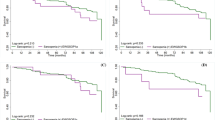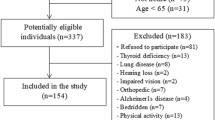Abstract
Background/Objectives:
Age-related muscle and fat mass (FM) changes are ethnicity specific. We aimed to develop a cut-point for the muscle mass component of sarcopenia for black South African (SA) women, and to assess its predictive value, in comparison to established cut-points, to identify functional ability among older black SA women.
Subjects/Methods:
In a cross-sectional study, a sarcopenia cut-point was calculated from dual energy X-ray absorptiometry (DXA)-derived appendicular skeletal muscle mass (ASM) indexes (ASMI) from two young black SA reference groups. The new cut-point was compared with the most recent Foundation for the National Institutes of Health (FNIH) criteria (ASM <15.02 kg; and ASMBMI <0.512), an internationally accepted cut-point (ASMI <5.5 kg/m2) and a residual method adjusting for FM. All cut-points were then applied to 221 older black women to predict gait speed and handgrip strength.
Results:
A cut-point of ASMI <4.94 kg/m2 was derived from the young SA reference groups. Using this cut-point, 9.1% of older women were classified as sarcopenic, compared with 16.7–38.7% using other cut-points. The only cut-points that significantly predicted low functional ability (low gait speed and low handgrip strength) in older black women were the new SA cut-point and the FNIH ASM criterion. Multivariate logistic regression models for both these cut-points significantly predicted low handgrip strength (odds ratio (OR)=3.71, P=0.007 and OR=3.42, P=0.001, respectively) and low gait speed (OR=9.82, P=0.004 and OR=8.71, P=0.008, respectively).
Conclusions:
The new SA cut-point had similar or greater odds of predicting reduced functional ability in older SA women when compared with other internationally accepted cut-points.
This is a preview of subscription content, access via your institution
Access options
Subscribe to this journal
Receive 12 print issues and online access
$259.00 per year
only $21.58 per issue
Buy this article
- Purchase on Springer Link
- Instant access to full article PDF
Prices may be subject to local taxes which are calculated during checkout

Similar content being viewed by others
References
Baumgartner R, Heymsfield S, Roche A . Human body composition and the epidemiology of chronic disease. Obes Res 1995; 3: 73–95.
Baumgartner R, Koehler K, Gallagher D, Romero L, Heymsfield SB, Ross RR et al. Epidemiology of sarcopenia among the elderly in New Mexico. Am J Epidemiol 1998; 147: 755–763.
Oliveira RJ, Bottaro M, Junior JT, Farinatti PTV, Bezerra LA, Lima RM . Identification of sarcopenic obesity in postmenopausal women: a cutoff proposal. Braz J Med Biol Res 2011; 44: 1171–1176.
Cawthon PM, Peters KW, Shardell MD, McLean RR, Dam TTL, Kenny AM et al. Cutpoints for low appendicular lean mass that identify older adults with clinically significant weakness. J Gerontol A Biol Sci Med Sci 2014; 69: 567–575.
Fielding R, Vellas B, Evans W, Bhasin S, Morley JE, Newman AB et al. Sarcopenia: an undiagnosed condition in older adults. Current consensus definition: prevalence, etiology, and consequences. International working group on sarcopenia. J Am Med Dir Assoc 2011; 12: 249–256.
Visser M, Schaap LA . Consequences of sarcopenia. Clinics Geriatr Med 2011; 27: 387–399.
Batsis JA, Barre LK, MacKenzie TA, Pratt SI, Lopez-Jimenez F, Bartels SJ . Variation in the prevalence of sarcopenia and sarcopenic obesity in older adults associated with different research definitions: dual-energy X-ray absorptiometry data from the National Health and Nutrition Examination Survey 1999-2004. J Am Geriatr Soc 2003; 51: 1602–1609.
Newman AB, Kupelian V, Visser M, Simonsick E, Goodpaster B, Nevitt M et al. Sarcopenia: alternative definitions and associations with lower extremity function. J Am Geriatr Soc 2003; 51: 1602–1609.
Studenski SA, Peters KW, Alley DE, Cawthon PM, McLean RR, Harris TB et al. The FNIH sarcopenia project: rationale, study description, conference recommendations, and final estimates. J Gerontol A Biol Sci Med Sci 2014; 69: 547–558.
Rush EC, Goedecke JH, Jennings C, Micklesfield L, Dugas L, Lambert EV et al. BMI, fat and muscle differences in urban women of five ethnicities from two countries. Int J Obes 2007; 31: 1232–1239.
Cruz-Jentoft A, Baeyens JP, Bauer J, Boirie Y, Cederholm T, Landi F et al. Sarcopenia: European consensus on definition and diagnosis: Report of the European Working Group on Sarcopenia in Older People. Age Ageing 2010; 39: 412–423.
Evans J, Micklesfield LK, Jennings CL, Levitt NS, Lambert EV, Ollson T et al. Diagnostic ability of obesity measures to identify metabolic risk factors in South African women. Metab Syndr Relat Dis 2011; 9: 353–360.
Crowther NJ, Norris SA . The current waist circumference cut point used for the diagnosis of metabolic syndrome in sub-Saharan African women is not appropriate. PLoS One 2012; 7: e48883.
Lane AB, Soodyall H, Arndt S, Ratshikhopha ME, Jonker E, Freeman C et al. Genetic substructure in South African Bantu-speakers: evidence from autosomal DNA and Y-chromosome studies. Am J Phys Anthropol 2002; 119: 175–185.
Vorster HH, Kruger A, Wentzel-Viljoen E, Kruger HS, Margetts BM . Added sugar intake in South Africa: findings from the Adult Prospective Urban and Rural Epidemiology cohort study. Am J Clin Nutr 2014; 99: 1479–1486.
Taekema DG, Gussekloo J, Maier AB, Westendorp RG, de Craen AJ . Handgrip strength as a predictor of functional, psychological and social health. A prospective population-based study among the oldest old. Age Aging 2010; 39: 331–337.
Guralnik JM, Ferrucci L, Pieper CF, Leveille SG, Makrides KS, Ostir GV et al. Lower extremity function and subsequent disability: consistency across studies, predictive models, and value of gait speed alone compared with the short physical performance battery. J Gerontol A Biol Sci Med Sci 2000; 55: M221–M231.
Malafarina V, Uriz-Otano F, Iniesta R, Gil-Guerrero L . Sarcopenia in the elderly: diagnosis, physiopathology and treatment. Maturitas 2012; 71: 109–114.
Lau EM, Lynn HS, Woo JW, Kwok TC, Melton LJ 3rd . Prevalence of and risk factors for sarcopenia in elderly Chinese men and women. J Gerontol B Psychol Sci Soc Sci 2005; 60: 213–216.
Kim CH, Park HS, Park M, Kim H, Kim C . Optimal cutoffs of percentage body fat for predicting obesity-related cardiovascular disease risk factors in Korean adults. Am J Clin Nutr 2011; 94: 34–39.
Domiciano DS, Figuerdo CP, Lopes JB, Caparbo VF, Takayama. L, Menezes PR et al. Discriminating sarcopenia in community-dwelling older women with high frequency of overweight/obesity: the Sao Paulo Ageing & Health Study (SPAH). Osteoporos Int 2013; 24: 595–603.
Lebrun CE, van der Schouw YT, de Jong FH, Grobbee DE, Lamberts SW . Fat mass rather than muscle strength is the major determinant of physical function and disability in postmenopausal women younger than 75 years of age. Menopause 2006; 13: 474–481.
Brameld JM . The influence of undernutrition on skeletal muscle development. Br J Nutr 2004; 91: 327–328.
Kruger HS, Steyn NP, Swart EC, Maunder EM, Nel JH, Moeng L et al. Overweight among children decreased, but obesity prevalence remained high among women in South Africa, 1999-2005. Public Health Nutr 2012; 15: 594–599.
Horta BL, Santos RV, Welch JR, Cardoso AM, Dos Santos JV, Assis AM et al. Nutritional status of indigenous children: findings from the First National Survey of Indigenous People's Health and Nutrition in Brazil. Int J Equity Health 2013; 12: 1–23.
Shisana O, Labadarios D, Rehle T, Simbayi L, Zuma K, Dhansay A et al South African National Health and Nutrition Examination Survey (SANHANES-1). Human Sciences Research Council: Cape Town, South Africa, 2013.
Acknowledgements
The work was funded by the South African National Research Foundation, the South African Medical Research Council, the International Atomic Energy Agency and the University of Cape Town. LKM acknowledges funding from the MRC/DFID African Research Leader Scheme. The funders had no role in study design, in the collection, analysis or interpretation of data, in the writing of the report or in the decision to submit the paper for publication. Any opinion, findings and conclusions or recommendations expressed in this material are those of the authors, and therefore the National Research Foundation does not accept any liability in regard thereto. Data analyses were conducted with assistance from Professor HS Steyn and S Ellis of the Statistical Consultation Service of the North-West University. We acknowledge the contribution to data analysis made by Treasure A Munonoka during his NRF internship at the UCT/MRC Research Unit for Exercise Science and Sports Medicine.
Author Contributions
The study was conceptualised and designed by HSK, JHG and LKM; HSK, JHG, LKM, HHW and LHN contributed to data collection; data analyses were performed by HSK, JHG and LKM, with assistance from Professor HS Steyn and S Ellis of the Statistical Consultation Service of the North-West University; and discussion of the data and writing of the manuscript was carried out by HSK, JHG, LKM, HHW and LHN.
Author information
Authors and Affiliations
Corresponding author
Ethics declarations
Competing interests
The authors declare no conflict of interest.
Rights and permissions
About this article
Cite this article
Kruger, H., Micklesfield, L., Wright, H. et al. Ethnic-specific cut-points for sarcopenia: evidence from black South African women. Eur J Clin Nutr 69, 843–849 (2015). https://doi.org/10.1038/ejcn.2014.279
Received:
Revised:
Accepted:
Published:
Issue Date:
DOI: https://doi.org/10.1038/ejcn.2014.279
This article is cited by
-
Relationship between DNA methylation changes and skeletal muscle mass
BMC Genomic Data (2023)
-
Understanding factors associated with sarcopenic obesity in older African women from a low-income setting: a cross-sectional analysis
BMC Geriatrics (2021)
-
Prevalence of Sarcopenia and Relationships Between Muscle and Bone in Indian Men and Women
Calcified Tissue International (2021)
-
Thoracic skeletal muscle quantification: low muscle mass is related with worse prognosis in idiopathic pulmonary fibrosis patients
Respiratory Research (2019)



